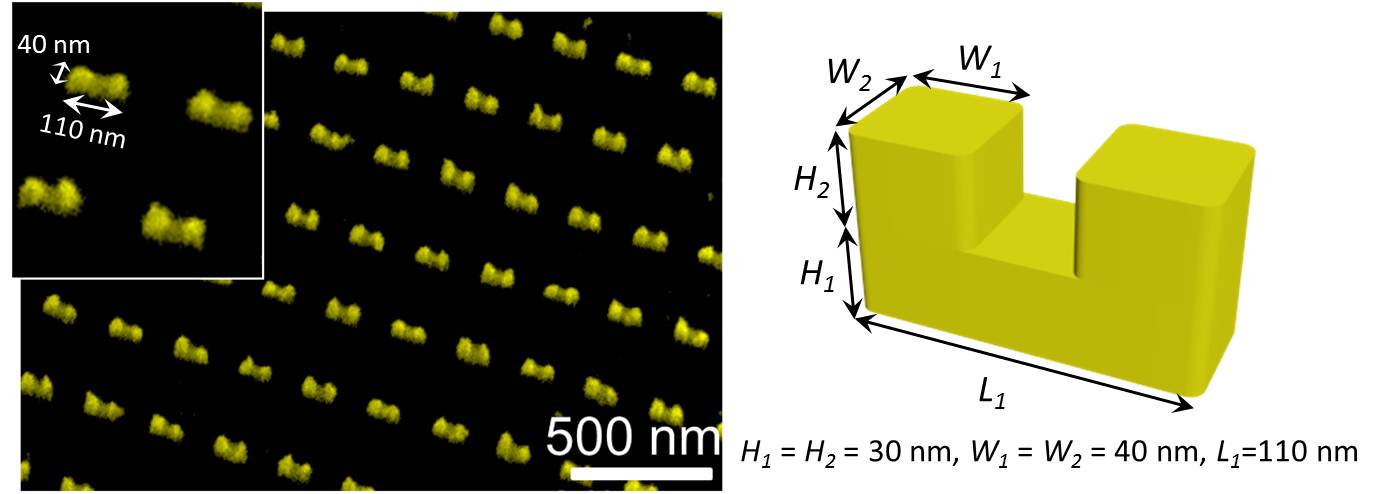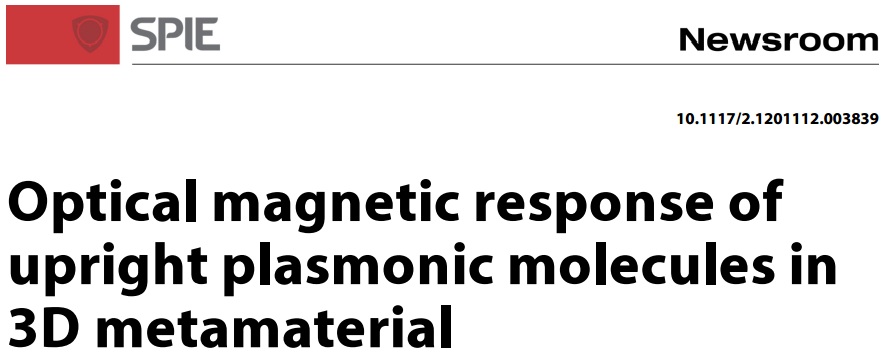
Double exposure e-beam lithographic process
Using electron beam lithography with a double exposure process, we fabricated 375 × 375 erected U-shape three-dimensional (3D) gold resonance rings on fused silica substrate, covering a total area of ~75 µm × 75 µm. For the precision alignment of e-beam double exposure process, two golden cross alignment marks are fabricated and used. For the first exposure process, the bottoms of resonance rings are defined in positive resist after first e-beam exposure and lift-off process. Subsequently, the two prongs of resonance ring are made by second e-beam exposure and lift-off process. The Espacer/poly methyl methacrylate bi-layered resist are spin-coated on a cleaned substrate. An e-beam lithography system at the high acceleration voltage and low current is used.

3D Metamaterial of Upright Plasmonic Meta-Molecules
We report the first three-dimensional photonic metamaterial, an array of erected U-shape plasmonic gold meta-molecules, that exhibits a profound response to the magnetic field of light incident normal to the array. The metamaterial was fabricated using a double exposure e-beam lithographic process. It was investigated by optical measurements and finite-element simulations, and showed that the magnetic field solely depends on the plasmonic resonance mode showing either enhanced in the centre of the erected U-shape meta-molecule (16 times enhancement) or enhanced around two prongs of erected U-shape meta-molecule (4 times enhancement).
Optical magnetic response in three-dimensional metamaterial of upright plasmonic meta-molecules
W. T. Chen, C. J. Chen, P. C. Wu, S. Sun, L. Zhou, G.-Y. Guo, C. T. Hsiao, K.-Y. Yang, N. I. Zheludev, D. P. Tsai
Optics Express 19(13), 12837 (2011).[Link] [PDF]

An array of fabricated U-shaped split-ring resonators shows a profound response to the magnetic field of light incident normal to the sample.
Optical magnetic response of upright plasmonic molecules in 3D metamaterial
W. T. Chen, P. C Wu, C. J. Chen, S. Sun, L. Zhou, G.-Y Guo, C. T. Hsiao, K.-Y. Yang, N. I. Zheludev, and D. P. Tsai
20 December 2011, SPIE Newsroom. DOI: 10.1117/2.1201112.003839 [Link]
|
|

Magnetic plasmon induced transparency
In a laser-driven atomic quantum system, a continuous state couples to a discrete state resulting in quantum interference that provides a transmission peak within a broad absorption profile the so-called electromagnetically induced transparency (EIT). In the field of plasmonic metamaterials, the sub-wavelength metallic structures play a role similar to atoms in nature. The interference of their near-field coupling at plasmonic resonance leads to a plasmon induced transparency (PIT) that is analogous to the EIT of atomic systems. A sensitive control of the PIT is crucial to a range of potential applications such as slowing light and biosensor. So far, the PIT phenomena often arise from the electric resonance, such as an electric dipole state coupled to an electric quadrupole state. Here we report the first three-dimensional photonic metamaterial consisting of an array of erected U-shape plasmonic gold nanostructures that exhibits PIT phenomenon with magnetic dipolar interaction between magnetic metamolecules. We further demonstrate using a numerical simulation that the coupling between the different excited pathways at an intermediate resonant wavelength allows for a π phase shift resulting in a destructive interference. A classical RLC circuit was also proposed to explain the coupling effects between the bright and dark modes of EIT-like electromagnetic spectra. This work paves a promising approach to achieve magnetic plasmon devices.
Magnetic plasmon induced transparency in three-dimensional metamolecules
P. C. Wu, W. T. Chen, K.-Y. Yang, C. T. Hsiao, G. Sun, A. Q. Liu, N. I. Zheludev, D. P. Tsai
Nanophotonics 1(2), 131-138 (2012) [Link]
|
|